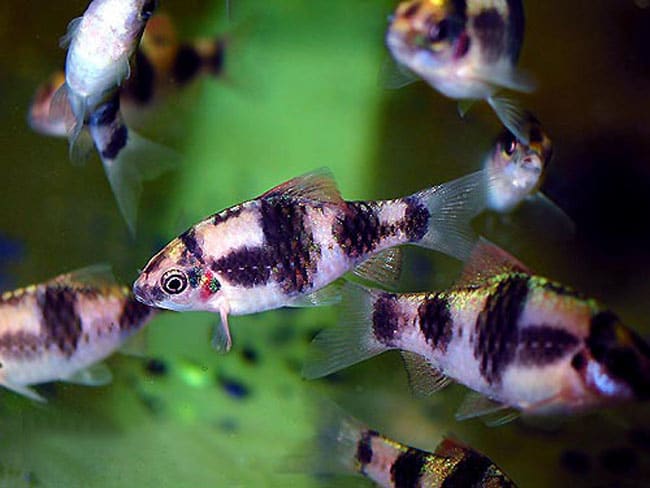
Barbus fasciatus originate from Southeast Asia, and are not often seen in the aquarium shops. George obtained the Barbus fasciatus when they were young from Bernie Halverson, and Bernie called them by the common name of Panda Barb, which when you look at them they certainly have that Panda appearance. In the aquatic literature weve found, they also go by the Banded Barb for a common name. I also noted that most of the pictures seen in books are of the female who are drab and plain looking. Even in The Barbs Aquarium booklet 2002 edition on page 65, youll note that although they do have a picture of an adult male, it still has not captured the true beauty of these Barbs. George and I came to the conclusion that perhaps people see them in the aquarium shops, but they are always all females, and plain looking, so they do not capture your eye. They could possibly be too young to show their full color, too.
When I had been looking for writing material for the Extended BAP, I noticed we needed something on Barbs. This called for a visit to Georges fish room, as he houses a wider variety of fish than I do on the two floors where my aquariums exist. After stating what I needed, George said no problem, as hed just spawned the Barbus fasciatus, and he proceeded to proudly show me the adults. They were absolutely beautiful! Wow! I didnt know Barbs could obtain such vibrant coloration. The adults were about 2 to 2-1/2 inches in length. The males really had it going on as far as color! Their facial and head area was grayish-black, and from there they showed a slight vibrant orange blush, which went from the head through their upper mid-body to their tail. A little past half the mid-body you note grayish dark bars and the first one has a circular appearance near the top of the body. And the dark markings also are near the top between the head and upper fins. The tail is also a deep orange blush. There is no way for me to describe the beauty of these fish on paper. You really need to see them. The female on the other hand is boring to look at with a beige-tan colored body, and markings the same as the male of gray-black in her body. She is the same length as the male, but not as deep bodied.
There were three males and one female of the Barbus fasciatus in the 10-gallon tank, including a pair of Peacock Gudgeons, and three Red Shiners. The tank was bare bottom with a sponge filter, a decorative haunted house for the fish to hide in, as well as mops galore all over the tank. We have Portage City tap water, and the temperature of the tank was 84 degrees. The tank received fifty percent water changes on a monthly basis, and the fish were fed baby brine shrimp and Wardleys Flake Food once a day. It was also a very active tank with the fish swimming about all over the tank. The Barbs were shy, and had to be coaxed out a number of times from hiding, so I could view them. They are schooling fish, so you should keep several together in a tank for their comfort.
When the mop was first searched for eggs, there was 24 eggs found, but one couldnt be sure who they belonged to, as the Red Shiners also scatter eggs when they spawn. These eggs were found in the evening, and they were tiny tannish-clear eggs the size of the head of a pin. They were placed in a small butter dish using Portage City tap water. No fungicides or anything else was added to the bowl. The eggs were simply watched and rinsed if the water became cloudy. After three days they hatched, and you could barely see the fry. Of the 24 eggs, 22 hatched. These were left in the bowl for a day after they hatched, as they werent ready to eat yet. They were then placed in a 1/2-gallon plastic shoe box with aged water, and an active sponge filter. Some newly hatched baby Snails were also added. The larger Snails had eaten babies in the past, so they are not used. After two more days baby brine shrimp was fed once a day.
Eventually one could see that twelve of them were the Barbus fasciatus and were about 1/8-inch long, clear bodied with a black spot on their dorsal. The remaining fry that were clear bodied were the Red Shiners babies. When the Barbs became even more visible you could see a spot between their body and tail, and their mid body. At three months they were about 1-inch in length, and were light orange with three dark strips down their eyes, mid-section, and just before their tail. They were capable of eating anything at that point, and were housed in a 1-gallon tank.
It still surprises me when I find another beautiful fish. It seems the aquatic world is limitless on the selection of fish we can obtain for our aquariums. These beautiful Barbs would make a great addition to your community tank, or are even worthy of a tank all to themselves.
Leave a Reply